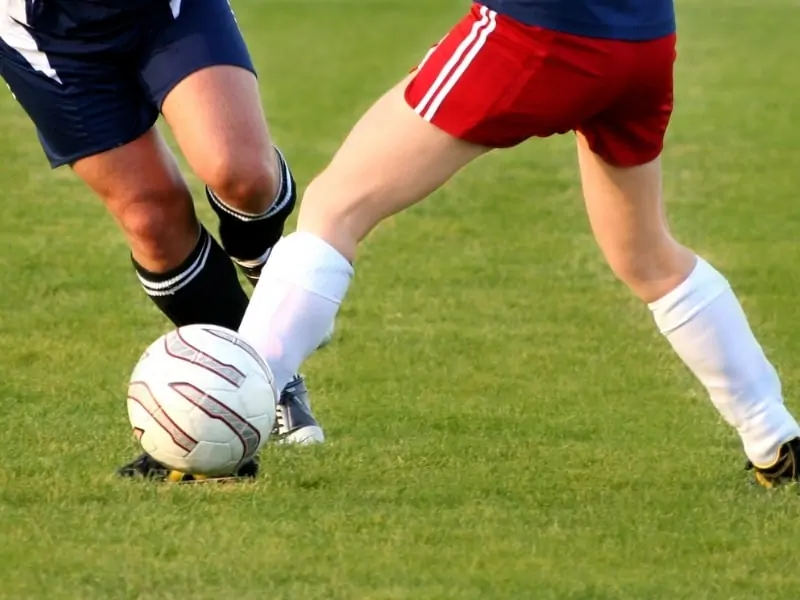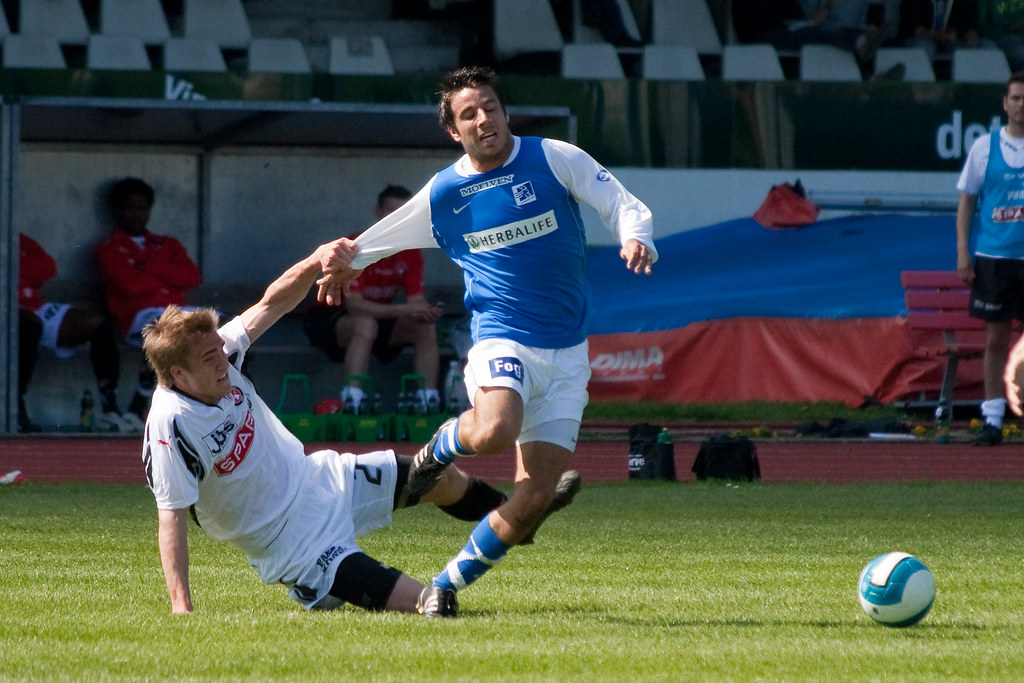Share the post "Blocking in Soccer (Game-Play or Obstruction)"
Blocking is an important part of many American sports, including football and basketball. It is a predominantly defensive move that often goes under the radar to viewers.
As one of the fastest-growing sports in the US, did you ever wonder, is blocking allowed in soccer?
In “the beautiful game”, blocking refers to two separate actions. It can mean deflecting the ball from a shot or pass, or it can mean physically impeding another player’s progress.
Depending on the specific circumstances, blocking may or may not be called a foul.
The key areas we’ll be covering include:
- What blocking is in soccer
- Positions that are responsible for blocking on the field
- How to effectively block the ball
- Blocking players and the obstruction rule
In this article, we talk about the different types of blocking and whether or not they are allowed in soccer.

Types of Blocking in Soccer
There are two main types of blocking in soccer: blocking the ball and blocking the player.
Blocking the Ball
This blocking involves using your body to prevent the ball from reaching the kicker’s target.
You can block a pass, shot, cross, or throw-in. It’s legal to block the ball using any part of the body other than the hands or arm (up to the shoulder).
Which Position Blocks the Ball the Most?
Blocking the ball is traditionally a defensive skill. Important blocks typically occur when a defender snuffs out an opposition player’s attempt at a shot, assist, or cross.
Blocking the ball is also an important skill for midfielders.
N’Golo Kante (Chelsea) is a master defensive midfield player with an incredible talent for intercept loose balls and blocking passing lanes, making him one of the most valuable players in today’s game.
An intelligent defensive midfield player can be an invaluable asset to a team, stopping attacks before they can even begin.
In modern soccer, many top teams “press from the front”. Essentially, this means that forward players apply significant pressure to opposition defenders while they are in the build-up phase of possession.
Pressing forwards always operate with the intention of intercepting or winning the ball back. It is the equivalent of a full-court press in basketball.
We’re now seeing certain forwards become exceptional blockers and interceptors.
Liverpool attackers Roberto Firmino, Mo Salah, and Sadio Mané have been some of the best pressers in European soccer over the last few years, terrorizing teams with their work ethic.
One of the modern masterminds behind pressing in the modern game had this to say about blocking the ball in the opponent’s half of the field:
“If you win the ball back high up the pitch and you are close to the goal, it is only one pass away a really good opportunity most of the time. No playmaker in the world can be as good as a good counter-pressing situation.”
Jurgen Klopp, Liverpool manager
While this tactic is common amongst top teams around the world, it has its drawbacks.
Overcommitting or failing to press as a unit makes teams vulnerable to counterattacks. Pressing also requires a lot of running, meaning players tire more quickly.
This can lead to a lack of sharpness toward the end of a game and may make players more susceptible to injury.

How to Block the Ball
People often think that blocking is a product of pure effort. In reality, it is a skill that involves 3 key components: positioning, timing, and athleticism.
Positioning
Every soccer player, at every level, from 10-year-old amateurs to veteran pros has had their coach yell at them to “stop ball watching”. While it’s easy to get side-tracked watching the game go by, players must be constantly aware of the space they occupy on the field.
Being in the right position involves reading the game and anticipating danger.
Have you ever noticed that the best defenders make the game look easy? This is because they have elite-level game intelligence, successfully predicting movement, passes, and avenues of attack.
Liverpool captain, Virgil Van Dijk, is a great example of a defender with exemplary positional sense.
He is a pro-active player who anticipates what’s going to happen, meaning he is constantly in control of the situation. He is very rarely caught out for being in the wrong position, allowing him to block and intercept at ease.
Van Dijk went on a streak of 65 games for Liverpool without getting dribbled past. Considering the level of competition he faced in the Premier League and Champions League, this is an incredible statistic.
Fans of the Dutchman can find his Liverpool 2021/22 jersey here.
Timing
Timing is crucial in soccer. It is often the difference between making a last-ditch interception and conceding a goal, tapping in a rebound or watching the defender clear the ball, and winning or losing.
Whether you’re intercepting a pass or blocking a shot, you must always try to time your movements to perfection. React too early and the player can easily take an extra touch and glide past you. Wait too long and you run the risk of your opponent getting a shot off.
Many players are instinctively adept at timing blocks, tackles, or interceptions. However, you can improve this area of your game through video study, coaching, and defensive drills.
Some players over-rely on their ability to time blocks and interceptions, leading to them getting caught out of position frequently.
Unfortunately, the best timing in the world can’t make up for poor positional sense.
While they may be few and far between, elite-level defenders boast positioning and timing qualities, making them a nightmare for attackers.
Former Manchester United center-back, Nemanja Vidic, had a knack for perfectly timing tackles, blocks, interceptions, and headers at both ends of the field.
Athleticism
At the end of the day, soccer is a sport contested by athletes. Athleticism enables some players to do what others can’t.
Players with pace, strength, jumping ability, and flexibility can pull off phenomenal blocks.
Sergio Ramos is the perfect example of an athletic defender. While he isn’t the tallest center-back, he is strong, quick, agile, and has an incredible vertical leap!
You’ll struggle to find a better athlete in his position that also possesses his defensive qualities and skill level.
Watch the master at work.
What’s Not Allowed
It is illegal to block the ball:
- With your hand or arm (up to the shoulder).
- With excessive force or excessive contact with the opposition player.
- From a free-kick if you’re standing within 10 yards of the taker.
- From goal kicks inside the penalty box.
- From penalty kicks, unless you’re the goalkeeper.
Handball
If an outfield player blocks the ball using an arm or hand, a foul is called, resulting in a free kick or penalty to the opposing team.
An intentional handball or an illegal handball that prevents a goal is generally punished with a red card.
However, not all handballs are deemed fouls.
There is room for interpretation within the rules at the discretion of the referee. What’s more, the specifics of the handball rule change from time to time, especially since the introduction of the video assistant referee (VAR) in major leagues around the world.
After the most recent changes by the International Football Association Board (IFAB), referees now rule an action as a handball offense if a player:
- Intentionally touches the ball with their hand or arm (up to the shoulder). In this instance, intentionally means moving their hand or arm towards the ball to initiate contact.
- Touches the ball with the hand or arm while making their silhouette unnaturally bigger. If the hand or arm is deemed to be in a natural position for the type of movement a player is making, the referee may not penalize them.
- Uses the hand or arm to score a goal (whether it is accidental or not).
- Uses the hand or arm to assist a teammate in scoring a goal.
- Uses the hand or arm to prevent the opposition from scoring a goal.
The exception to the handball rule is the goalkeeper. They are allowed to use any part of their body to block the ball, as long as they are inside their own penalty box.
As soon as a goalkeeper steps outside their penalty box, they are considered an outfield player in terms of handball.
Blocking the Player
Although soccer is a contact sport, intentionally blocking an opposition player by holding them, pulling their jersey, tripping them, or charging at them is a foul.
Intent plays an important role in determining blocking fouls, known in soccer as obstruction.
Impeding the movement of a player without any intention of gaining possession of the ball is illegal.
This is why shoulder to shoulder contact is generally allowed when players are challenging for the ball but is regarded as a foul if it occurs away from the ball.
In most cases, it is legal to block a player if you fairly dispossess them while doing so.
Like with blocking the ball, positioning is key when it comes to tackling and blocking opponents fairly. According to the rules of the game, all players are entitled to hold their position on the field.
There is a clear distinction between being in the way of the opposition and intentionally moving into their path to block them.
Positioning, timing, and anticipation will help you improve defensively, enabling you to halt attacks without committing fouls.
Share the post "Blocking in Soccer (Game-Play or Obstruction)"
Joel is a seasoned soccer journalist and analyst with many years of experience in the field. Joel specializes in game analysis, player profiles, transfer news, and has a keen eye for the tactical nuances of the game. He played at various levels in the game and coached teams - he is happy to share his insight with you.



